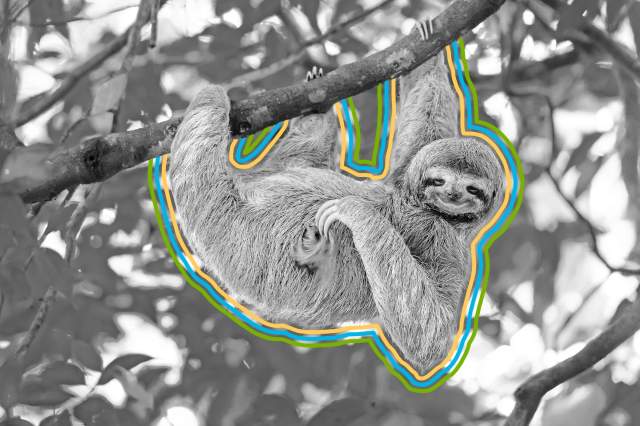
Sloths Navigate Mostly By Touch
Sloths don’t have great hearing or eyesight, so they navigate the world primarily by touch using their incredible spatial memory — and they have a keen sense of smell, which helps them find food. Their vision is especially bad; sloths have a condition called monochromacy, meaning they have no cone cells in their eyes at all. This makes them not only colorblind, but mostly blind in dim light and completely blind in bright light. Three-toed sloths can’t even see 5 feet in front of them.

For Tree-Dwelling Animals, They Have a Terrible Sense of Balance
Despite living high up in trees, sloths have little use for balance; they hook themselves onto trees firmly (so firmly, they can sleep suspended), and move very slowly. Since sloths don’t need the same level of motion control as many other mammals, the mechanisms that help a human or a squirrel, for example, find their footing in a tree eroded over generations. When sloths do lower themselves to the ground, usually for their once-per-week trip to the bathroom, they have a lot of trouble moving around gracefully.

Sloths Are Weirdly Good Swimmers
Sloth senses, their musculature, and even their ears have evolved almost perfectly for a narrow set of circumstances: hanging from trees, and moving slowly around trees. On the ground, they’re clumsy and vulnerable. So it might surprise you that they’re actually kind of speedy swimmers. Amazingly, they move three times as quickly in the water as they do in trees. The gas in their stomachs makes them surprisingly buoyant, so all they have to do is paddle those big long arms to cross even wide rivers in the Amazon.
More Interesting Reads

The Three-Toed Pygmy Sloth Is Critically Endangered
Three-toed pygmy sloths are the smallest in both size and population. They’re about 40% lighter than brown-throated sloths, and only became recognized as a distinct species in 2001. Sadly, they are critically endangered, meaning they have an extremely high risk of becoming extinct. Three-toed pygmy sloths started evolving separately from their larger counterparts on Escudo de Veraguas, an island that became isolated from mainland Panama around 9,000 years ago. Researchers still don’t know a lot about their diet, habitat, or even their population — it could be anywhere between 500 and 1,500.
Most sloths are not endangered. However, the maned three-toed sloth, which lives along a small stretch of rainforest coastline in southeastern Brazil, is considered vulnerable.

Sloth Fur Contains an Entire Ecosystem
Each strand of sloth fur contains microcracks, which, along with the creatures’ extremely slow speed, allows algae and fungi (some that aren’t found anywhere else) to grow freely. That algae turns green and creates an extra layer of camouflage for the animals during rainy seasons. Sloth fur is also home to multiple unique species of moths that rely on sloths for survival. When sloths descend to the forest floor for their weekly bathroom break, the moths lay eggs in the dung, which then hatch and fly up to the trees to return to the sloth’s fur. When the insects die and decompose, they fertilize the algae, creating more camouflage and, perhaps, a nutritious snack for grooming sloths.
Gross as it may sound, that dirty fur could hide some medical miracles, thanks to some sloth-exclusive fungi. One researcher found at least 28 distinct strains growing on a three-toed sloth, some with the potential for treating diseases — including breast cancer.

Elephant-Sized Sloths Used To Roam All of North America
Today, sloths seem elusive. They live exclusively in lowland forests in Central and South America, and spend most of their time camouflaged high up in the treetops. However, they were far more commonplace for our human ancestors of the late ice age, who could have encountered sloths the size of elephants as far north as Alaska and the Yukon Territory. One fossil was even found more than 8,000 feet above sea level in the Rocky Mountains.
Large clawed ground sloths (Megalonyx) grew to about 10 feet long and weighed around 2,200 pounds. Shasta ground sloths were a little smaller, and had a much narrower habitat, but were still quite large at 9 feet long and up to 550 pounds. You may have extinct giant sloths to thank for avocados existing, since they were one of a handful of large mammals able to swallow an entire avocado pit and pass it in a new location, allowing more trees to grow. However, humans eventually had to take over cultivation of avocados manually.












